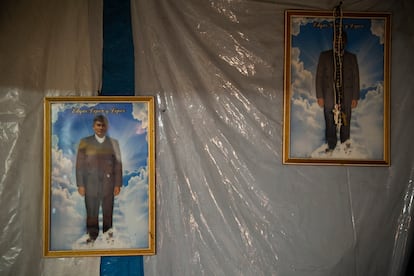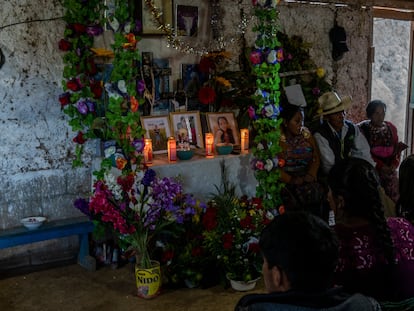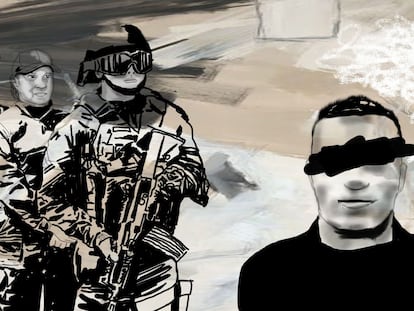Unanswered questions about massacre of 19 migrants in Mexico: ‘Why did the police execute them?’
The Prosecutor’s Office has asked for a total of 969 years in prison for 11 police officers involved in the migrant massacre. For the repentant officer – who has been key to building the case – prosecutors are asking that he receive a reduced sentence of 19 years

The “anguish of imminent death,” explains the French lawyer Frédéric Bibal, is “the feeling of dread experienced by the victim who – between the moment they suffered the attack or aggression and the moment of death – has become aware of the ineluctable nature of their own end.” This is a bureaucratic way of describing the absolute terror that comes with the certainty of a violent end.
In the hearings for the Camargo case in Mexico – which should come to an end this week – it has been difficult not to think about this notion of terror. This anguish symbolizes the doubts that come with a drawn-out legal process… but also the doubts that come with an incomplete one.
Last week, a judge sentenced 12 police officers for the murder of 19 people – most of them migrants – in the municipality of Camargo, in northern Mexico. The massacre took place just over two-and-a-half years ago. It’s a pioneering sentence: the first case of homicidal violence against migrants that has ended with a conviction in Mexico. Many more pending cases are on the horizon, including the unpunished massacres of San Fernando, a few hundred miles to the south of Camargo, which took place just over a decade ago.
Convictions offer some relief to the families of victims, but they cannot heal the wounds. Questions persist about the dozen other police officers involved – ignored by the authorities – and about how and why the massacre occurred.
Failures in the internet connection at the court have postponed the end of the trial… a situation that has been repeated several times in the final stretch of the legal process. Last week, the presiding judge suspended the hearing in which he was going to read his ruling, because there was no wifi.
Of the 12 police officers identified, the judge finally convicted 10 of homicide, abuse of authority and crimes in how they carried out their administrative functions. To another agent, he also added the charge of giving false information in reports. The last one – the collaborating police officer, Ismael Vázquez – was charged with abuse of authority and crimes related to the failure to carry out administrative functions.
This past Tuesday, the hearing was scheduled for the judge to impose the sentences on each of the 12 men, but internet difficulties at the Comprehensive Justice Center in Ciudad Victoria – the capital of the Mexican state of Tamaulipas – prevented this from happening.
The prosecutor has had time, however, to present the judge with the sentences that she considers to be appropriate for those convicted: 969 years in prison for the first 10 officers, 975 for the 11th, and 19 years in jail for police officer Vázquez.
This averages out to about 50 years per officer – the maximum sentence – for each of the 19 murder victims, in addition to more years behind bars for lesser crimes. The prosecutor has requested a significantly-reduced sentence for the repentant police officer, because, without him, the case wouldn’t have been able to proceed. These numbers – in any case – are fictitious. The figures serve to calculate the size of the horrors, but they do little else. The Tamaulipas penal code establishes that no one can spend more than 50 years in prison. The session resumed on Wednesday, September 20.
There’s a legal intention to defining the anguish of imminent death. Bibal used the concept a couple of years ago, in the trials for the perpetrators of the Paris terrorist attacks in November of 2015, which left 131 people dead. Those attacks on public places across the French capital – such as the Bataclan Hall, the national stadium and various terraces – resulted in Bibal and his firm calculating “reparations for bodily harm.” That is, determining how much the life and suffering of those who perished was worth… and the suffering of those survived. Dying on the spot isn’t the same as being wounded and waiting for the shot, while you listen to the perpetrators, their weapons, their words. Whether you survive or not.
In the Camargo case, however, there were no survivors. 16 Guatemalan citizens were murdered, most of them from the town of Comitancillo, in the southern mountains of the Central American country. A Salvadoran and two Mexicans – alleged to be the people-traffickers – also died. It’s possible that more vans were part of the convoy of migrants trying to reach the US-Mexico border… at least, this is what several witnesses who lived near the scene of the crime have stated. In any case, if there were more migrants, they continued on their way. All those who remained there died at the hands of police. First, they were shot at. The survivors were then finished off. Finally, the officers burned their bodies.
Following the massacre, one of the questions that the families of the deceased asked themselves was precisely related to the suffering experienced by their loved ones – if they died from the bullets, or if they were still alive when the fire started. The autopsies eased the anguish: everyone was already dead when the flames began to consume the bodies. But the matter didn’t end there. The repentant police officer Vázquez pointed out that, after the first attack, his boss – the commander of the special operations group (GOPES) of the Tamaulipas police department, Horacio Rocha Nambo – ordered him to put four women in the trunk of one of the two vehicles that appeared at the scene of the crime. There, Vázquez saw bodies of men “all piled up. Some were injured and others were already dead.”
At least a quarter of the 19 murder victims were alive after the first attack. They were then piled into a van, before being shot and set on fire. What did they think? Did they know that they were going to be killed, that their bodies were going to be burned, to the point that the bones would break? The families wondered: did they suffer? Did they feel anguish?
Acclaimed novelist Emmanuel Carrère – who covered the Paris trials and wrote a book about the events, V13 – remembered the words of French philosopher Emmanuel Levinas, while listening to the testimonies of the victims: “As soon as you scrutinize the face of a human being, it’s more difficult to kill him.” Did the perpetrators look into the eyes of the fallen, those who were still living?
The Camargo case has been a delicate process: it depended so much on the repentant police officer, that asking him to expand on his statement almost seemed reckless. His words confirmed that the story told by his11 colleagues was a lie – there was no room for other moral questions to be discussed. But the questions exist. And, above all, they point to a bigger question: why did the officers do this?
In Mexico, the reparations that are paid to the victims and the families of victims are measured on an individual basis, depending on the damage caused. The request of the Tamaulipas Prosecutor’s Office and the State Commission for Assisting Victims is that the figure be 6.1 million pesos per police officer. That is, just over 73 million pesos in total, which would amount to a distribution of about 3.8 million pesos for each family… about $220,000. Of course, this is a quick calculation. It’s not clear if the judge will accept this figure, or find that the funds should be distributed equally between the affected families.
In any case, amounts like this are important for residents of towns such as Comitancillo, which see its young people journey to the north with around $1,000 or $1,500 in their pockets. The emotional damage to the families is also included in the calculation, although the Commission and the Prosecutor’s Office haven’t yet detailed how they have calculated said damage. In this Wednesday’s session, the Prosecutor’s Office will call two experts to testify, who will apparently detail the arithmetic behind the reparations.
In the mountains of southern Guatemala, the events of the last sessions – the conviction, the request for penalties – have reached the families via videoconference. The reactions vary. Álvaro Miranda – the father of Ósmar, a boy who was 19-years-old at the time of his death – says: “We already know what the sentence is; we’re waiting for them to say how much each person gets. The question is, why were they executed in this way? It hasn’t been cleared up, we don’t know… only the police were the executors. Was it because they weren’t paid? We know that the mafia gets paid off. [The court] should have asked the police officers about this.”
Miranda’s pain – the enormous void of not knowing – collides with Ricardo García’s satisfaction. His daughter – Santa Cristina – was 20-years-old when she was murdered in Camargo. “I’m not satisfied with the sentence, because no matter what, my daughter isn’t going to return. But I feel happy, proud, because the voice of each family was heard.”
“I don’t want history to repeat itself,” he adds. “We’ve achieved a victory. Not for me, but for the municipality, for the department of San Marcos, for Guatemala and other countries that [see its people] cross the border. What happened to our deceased has no name. It makes me happy that we’ve achieved justice… we don’t know how many years [the 12 accused] are going to get, but they’re condemned, they’re going to pay.”
García also has a message of peace. “It’s not that I feel happy because they’re going to be in jail, no. But I feel free. I forgive them for taking my daughter’s life. Yes, I forgive them. I’m human, I need forgiveness too. I forgive you for taking my daughter’s life. I forgive the 12 [perpetrators]. But they have to pay for what they did. It’s a forgiveness that’s born in my heart, but at the same time, they’re going to pay for what they did.”
Sign up for our weekly newsletter to get more English-language news coverage from EL PAÍS USA Edition
Tu suscripción se está usando en otro dispositivo
¿Quieres añadir otro usuario a tu suscripción?
Si continúas leyendo en este dispositivo, no se podrá leer en el otro.
FlechaTu suscripción se está usando en otro dispositivo y solo puedes acceder a EL PAÍS desde un dispositivo a la vez.
Si quieres compartir tu cuenta, cambia tu suscripción a la modalidad Premium, así podrás añadir otro usuario. Cada uno accederá con su propia cuenta de email, lo que os permitirá personalizar vuestra experiencia en EL PAÍS.
¿Tienes una suscripción de empresa? Accede aquí para contratar más cuentas.
En el caso de no saber quién está usando tu cuenta, te recomendamos cambiar tu contraseña aquí.
Si decides continuar compartiendo tu cuenta, este mensaje se mostrará en tu dispositivo y en el de la otra persona que está usando tu cuenta de forma indefinida, afectando a tu experiencia de lectura. Puedes consultar aquí los términos y condiciones de la suscripción digital.
More information

The Tamaulipas massacre: how the American Dream dies in Mexico
Archived In
Últimas noticias
Most viewed
- Reinhard Genzel, Nobel laureate in physics: ‘One-minute videos will never give you the truth’
- Oona Chaplin: ‘I told James Cameron that I was living in a treehouse and starting a permaculture project with a friend’
- Pablo Escobar’s hippos: A serious environmental problem, 40 years on
- Chevy Chase, the beloved comedian who was a monster off camera: ‘Not everyone hated him, just the people who’ve worked with him’
- Why we lost the habit of sleeping in two segments and how that changed our sense of time










































